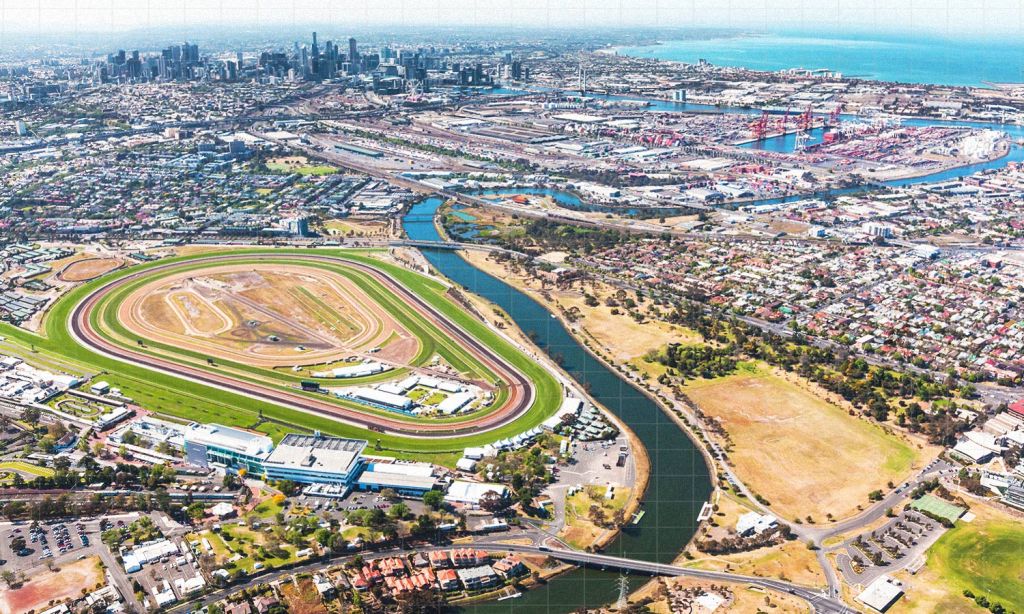An icon of Australia, Flemington Racecourse has come under fire in recent days for its apparently un-Australian means of protecting the hallowed grounds.
The home of the Melbourne Cup has angered locals for its floodwall that some are claiming has protected the track while increasing the impact of flooding on the surrounding areas.
Around 100 properties were flooded in Maribyrnong last Friday, with mud and debris now coating the streets. The cost of the clean-up is estimated to be in the millions and the three-metre wall around Flemington has become the local focus point of anger and frustration after the disaster.
Arial photos emerged during the flooding which revealed the extent of the waters in residential areas, sharply contrasted with the dry, manicured laws on Flemington.
The Flemington Racecourse flood wall is some kind of perverse tragedy of the commons. A privately-owned floodplain refusing to take on water, ensuring worse flooding for the city of Melbourne. pic.twitter.com/1kXcFjX8L3
— Alistair Kitchen (@alistairkitchen) October 14, 2022
The Victorian Greens have ripped into the racetrack and its owner, the Victorian Racing Committee, demanding that they foot the bill for the cost of cleanup.
Tensions were only heightened after Melbourne Racing Club chairman Mike Symons posted to social media congratulating his colleagues in the industry for their work in preventing the track from flooding.
“Credit to former chairman Michael Burn & VRC committee for the considerable investment into the bund wall to prevent the 100-year flood event from impacting the Melbourne Cup carnival,” he wrote.
Flemington is literally built on 1.2 million square metres of floodplain, which undoubtedly would have soaked up some of the water before it could make its way into the streets. Residents have said that the flooding they experienced is exactly why they campaigned against the floodwall being built back in 2007 when it was first erected.
Former Maribyrnong Mayor, Janet Rice, has said that the wall has “undoubtedly made the flood worse”.
“Looking at the photos of water being walled off from the racecourse, it shows exactly why we were campaigning against it,” she said.
The three-metre wall was only built because planning minister Mary Delahunty overturned attempts by the City of Melbourne, and Maribyrnong and Moonee Valley councils to block it.
“Melbourne Water’s modelling confirms that provided the compensatory works are in place, there is no increase in risks to people and property in the river valley,” Delahunty said at the time.
It appears that that modelling may well now be in question, as Premier Dan Andrews has announced that there will now be an inquiry into the impact of the floodwall on local residents.
“I can confirm that Melbourne Water will conduct a thorough review of that flood event, and any impact that had. It will do that work at arm’s length from the government and will report on its progress,” he said.
One local family, the Trewins, has been at the heart of the campaign to fight the wall ever since its proposal. Tyson Trewin said that floodwaters came much higher into their home last week than during any previous flood.
“[Racing Victoria] were worried about getting their grass wet and a little bit muddy. Horses were worth more than our lives,” he said.
The Victorian Racing Committee have acknowledged that their wall likely had “unintended consequences for neighbouring residents” but that they are “entitled” to protect their property.
Horse racing brings in millions of dollars each year, with the Melbourne Cup as the star event in the racing calendar. A 2018 study found that the economic return on the event was $447.6 million, with 325,000 people in attendance. Since the racetrack was built, in 1854, it’s been flooded at least nine times. A nightmare event for the Victorian Racing Committee, and the Victorian government, would be a stop to the race that stops the nation because of flooding.
Those were the economic arguments put forward in support of the construction of the flood wall in 2007.
“[The VRC] got what they wanted, it was quite inappropriate that it happened but they managed to convince the government at the time,” Rice said. “The VRC said at the time you couldn’t possibly have the Cup carnival interrupted. It just says to me the level of influence that the gambling industry has on Victoria.”
To make matters worse, Melbourne Water is proposing the building of a second flood wall, just 200m north of Flemington, in an effort to turn the flood-prone area into a mini-riverside suburb. It’s part of Melbourne City Council’s $230 million plans for a Maribyrnong Waterfront precinct, which includes a 14-story “sky neighbourhood” complete with bars, restaurants, and housing.
Walling the wealthy off from the natural disasters that spring from overconsumption and unsustainable living practices is just the logical conclusion of climate denial and inaction. Situations like the one we saw last week are only going to increase as the effects of climate change get worse. While the livelihoods, family heirlooms, and photographs of local residents are washed into the streets, the ultra-rich will always manage to protect their own assets as climate change becomes a game of every man for himself.
The Flemington flood was created by a heady mix of gambling money influencing poor planning decisions that fail to take into account our changing environment but it won’t be the last natural disaster inspired by similar logic. If you want a glimpse of the future of the country, look no further than the Flemington Racecourse’s floodwall.
In a few weeks, hundreds of thousands of punters will once again flock to the tracks to throw money on horses and throw up in portaloos. At least their shoes will be mud-free while they do it.
Related: So Here It Is, Merry Climate Change, Nobody’s Having Fun
Related: Local Heroes Get Stuck in to Help During NSW and VIC Floods
Read more stories from The Latch and subscribe to our email newsletter.







